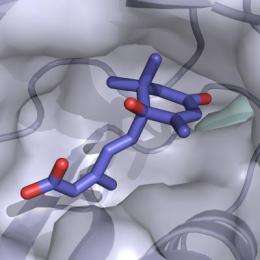Research spawns new discoveries showing how crops survive drought

(PhysOrg.com) -- Breakthrough research done earlier this year by a plant cell biologist at the University of California, Riverside has greatly accelerated scientists' knowledge on how plants and crops can survive difficult environmental conditions such as drought.
Working on abscisic acid (ABA), a stress hormone produced naturally by plants, Sean Cutler's laboratory showed in April 2009 how ABA helps plants survive by inhibiting their growth in times when water is unavailable - research that has important agricultural implications.
The Cutler lab, with contributions from a team of international leaders in the field, showed that in drought conditions certain receptor proteins in plants perceive ABA, causing them to inhibit an enzyme called a phosphatase. The receptor protein is at the top of a signaling pathway in plants, functioning like a boss relaying orders to the team below that then executes particular decisions in the cell.
Now recent published studies show how those orders are relayed at the molecular level. ABA first binds to the receptor proteins. Like a series of standing dominoes that begins to knock over, this then alters signaling enzymes that, in turn, activate other proteins resulting, eventually, in the halting of plant growth and activation of other protective mechanisms.
"I believe Sean's discovery is the most significant finding in plant biology this year and will have profound effects on agriculture worldwide," said Natasha Raikhel, the director of UC Riverside's Center for Plant Cell Biology, of which Cutler is a member. "Because the ABA receptor is so fundamentally important for understanding how plants perceive various environmental stresses, I am sure the strings of research that Sean's discovery sparks will be endless."
In only months since Cutler's discovery, six research papers in prestigious journals such as Science and Nature have been published that build on his work, a testament to the interest among plant scientists to nail down how exactly the stress signaling pathway works in plants. This intense activity in the field was expedited by Cutler's willingness to share information with colleagues before his own research was published - an open approach that is at odds with the often cutthroat competition in hot scientific areas.
"This intense interest by the scientific community will certainly accelerate the development of new agrichemicals that can be used to control stress responses in crops, and I believe we need to work openly to tackle problems of such great importance," said Cutler, an assistant professor of plant cell biology in the Department of Botany and Plant Sciences. "There is also tremendous interest from industry, and we are moving closer to designing both improved chemicals that can control drought tolerance in crops and improved receptor proteins that can be used to enhance yield under drought conditions. Ultimately, my vision is to combine protein and chemical design to usher in a fundamentally new approach to crop protection. These recent papers are an important step towards realizing that goal."
Determining how the chemical switch works
One of the six research papers that builds on Cutler's work is published online Nov. 18 in Nature. The research, led by an-Kang Zhu, a professor of plant cell biology at UCR, fleshes out the domino pathway from the receptor down to the proteins that control plant growth.
"Freshwater is a precious commodity in agriculture," Zhu said. "Drought stress occurs when there is not enough freshwater. We wanted to understand how plants cope with drought stress at the molecular level. Such an understanding is necessary if we want to improve the drought tolerance of crop plants through either genetic engineering or marker-assisted breeding."
In their Nature paper, Zhu and his colleagues report on how they reconstituted in a test tube the process of information transfer from receptor to phosphatase, and all the way downstream to the protein that turns the gene on or off, and then ultimately to the gene itself.
"The ABA signaling pathway we reconstituted is arguably the most important pathway for plants to cope with drought stress." Zhu said. "This is the first time the whole pathway has been reconstituted in vitro. What is emerging is a clear picture of how the chemical switch works - useful knowledge for designing improved chemical agents for application in crop fields."
Zhu explained that in vivo studies (done in the living body of the plant) involve thousands of proteins, which can complicate data interpretation. By doing the study in vitro (outside the living body of the plant) his lab avoids this problem, making it possible to determine the minimal number of components necessary and sufficient for the ABA response pathway.
Next in its research, the Zhu lab will use the knowledge of the ABA response pathway to make transgenic plants that will have substantially higher levels of drought tolerance, achieved by manipulating the levels and activities of the key components of the pathway. The lab also plans to investigate how drought stress triggers the production of ABA.
Zhu was joined in the research by Cutler and UCR's Hiroaki Fujii, Viswanathan Chinnusamy, and Sang-Youl Park. Americo Rodrigues, Silvia Rubio, Regina Antoni and Pedro L. Rodriguez of the Instituto de Biología Molecular y Celular de Plantas, Spain; and Jen Sheen of the Massachusetts General Hospital also collaborated on the study.
Zhu was funded by a grant from the National Institutes of Health. Currently, he has an appointment also at the King Abdullah University of Science and Technology, Saudi Arabia.
The other five research papers that Cutler's research inspired discuss the molecular structure of the ABA receptor, showing in atomic detail how ABA functions to trigger signaling.
Source: University of California - Riverside (news : web)



















